/Vehicles/Axis/Germany/08-Halftracks/Zugkraftwagen/File/Zugkraftwagen-pg4.htm | Last Up-date: 12-07-2024
Zugkraftwagen (Prime Movers)
Sd.Kfz.10 leichte Zugkraftwagen
1t/ Sd.Kfz.10/1 leichte Gasspürkraftwagen
Sd.Kfz.10/2 leichte Entgiftungskraftwagen / Sd.Kfz.10/3 leichte Sprühkraftwagen
/
Sd.Kfz.10/4 leichte Selbstfahrlafette mit 2 cm Flak 30 /
Sd.Kfz.10/5 leichte Selbstfahrlafette mit 2 cm Flak 38 / 37 mm Pak 35/36
auf ZgKw 1t /
50 mm Pak 38(Sf) auf ZgKw 1t
Le Sd.Kfz.10 qui était un tracteur d'artillerie léger, possédait un remarquable comportement en tout-terrain et une grande fiabilité ce qui en fit un des véhicules favoris de la Panzertruppe. Son développement débuta en 1932, quand l'armée allemande demanda à la compagnie Demag de développer un véhicule tout terrain à multiple usage. Le prototype fut prêt en 1934 et la production du D-7 débuta en 1937. Sa production dura jusqu'en 1944 avec environ 17000 spécimens produits par Demag, Adler, Buesing-NAG, Saurer et Phaenomen. MIAG, MNH participèrent également à la production. Notons qu'environ 7500 exemplaires seront reconvertis en leichter Schützenpanzerwagen (Sd.Kfz.250). Il fut conçu pour remorquer différents équipements (comme le lance-roquettes Nebelwerfer 42)mais on l'utilisa également comme affût mobile pour le canon antiaérien FLAK 30 et 38 de 37 mm.
Sd.Kfz.10 which was a light artillery tractor, had a remarkable behavior in cross-country and a great reliability what did of it one of the favorite vehicles of Panzertruppe. Its development began in 1932, when the German army asked to company DEMAG to develop a multiple purpose cross-country vehicle. The prototype was ready in 1934 and the production of D-7 began in 1937. Its production lasted until 1944 with approximately 17000 specimens products by DEMAG, Adler, Buesing-NAG, Saurer and Phaenomen. MIAG, MNH also took part in the production. Let us note that approximately 7500 specimens will be reconverted in leichter Schützenpanzerwagen (Sd.Kfz.250). It was conceived to tow various equipment (as the Nebelwerfer 42 rocket launcher) but one also used it like mobile mounting for anti-aircraft gun FLAK 30 and 38 of 37 mm.
 |
 |
Sd.Kfz.10 leichte Zugkraftwagen
1t (Demag D7)
|
|
src: Site Lexikon
der Wehrmacht |
src: Site Lexikon
der Wehrmacht |
Cet engin fut utilisé sur tous les fronts durant la deuxième guerre mondiale et devint très populaire auprès des soldats allemands, surtout en Russie où l'état du terrain était très mauvais durant la mauvaise saison. Le Sd.kfz 10 fut l'un des véhicules les plus importants de l'armée allemande (le 20 décembre 1942, elle en comptait 11116 en service) et fut utiliser pour accomplir des tâches multiples. Il servit également dans la Luftwaffe comme affût mobile pour canons antiaériens sur les terrains d'aviation.
This machine was used on all fronts during the Second World War and became very popular near the German soldiers, especially in Russia where the condition of the ground was very bad during the bad season. Sd.kfz 10 was one of the most significant vehicles of the German army (on December 20, 1942, it counted 11116 in service of it) and was to use to achieve multiple tasks. It was also useful in Luftwaffe like mobile mounting for anti-aircraft guns on the airfields.
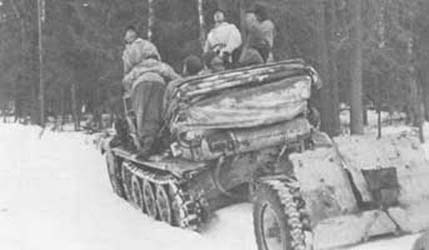 |
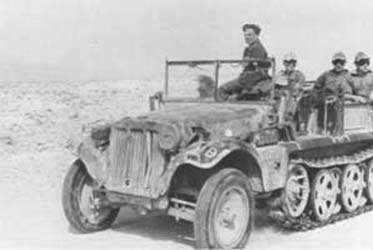 |
Sd.kfz.10 tractant un obusier d'infanterie
de 75 mm sur le front russe. |
Demag D7 en Afrique du Nord. |
Sd.kfz.10 trowing a 75
mm infantry howitzer on Russian front. |
Demag D7 in North Africa |
src: Afrikakorps in Action,
squadron/signal publications |
Data |
La plupart des exemplaires produits étaient conformes au modèle de base. Des variantes furent tout de même produite: Sd.Kfz.10/1 Gasspurekraftwagen: Détecteur de gas - Sd.Kfz.10/2 Entgifungskraftwagen: Véhicule de décontamination - Sd.Kfz.10/3 Spruhkraftwagen: Véhicule d'incendie - Sd.Kfz.10/4: Affût mobile pour 20 mm Flak 30 antiaérien - Sd.Kfz.10/5: Affût mobile pour 20 mm Flak 38 antiaérien.
The majority of the produced specimens were in conformity with the basic model. But alternatives were produced: Sd.Kfz.10/1 Gasspurekraftwagen: Detector of gas - Sd.Kfz.10/2 Entgifungskraftwagen: decontamination vehicle - Sd.Kfz.10/3 Spruhkraftwagen: fire vehicle - Sd.Kfz.10/4: Mobile mounting for 20 mm anti-aircraft Flak 30 - Sd.Kfz.10/5: Mobile mounting for 20 mm Flak 38 anti-aircraft.
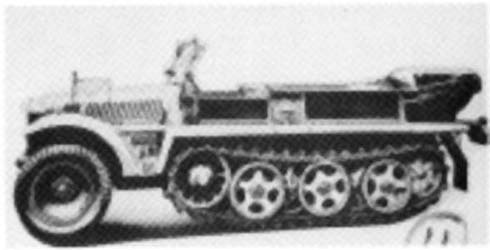 |
 |
Sd.Kfz.10/1 Gasspurekraftwagen |
Sd.Kfz.10/2 leichte Entgifungskraftwagen. |
src: Site Lexikon
der Wehrmacht |
src: Site Lexikon
der Wehrmacht |
 |
Sd.Kfz.10/3 leichte Spruhkraftwagen.
|
src: Site Lexikon
der Wehrmacht
|
Le Sd.Kfz.10 standard fut également équipé d'une superstructure arrière spéciale avec côtés rabbatables pour accuillir le canon antiaérien de 20 mm Flak 30 ou 38 L/112.5 à rotation complète. Ce fut l'un des premiers véhicules antiaériens utilisés par les Allemands. Un total de 370 fut produit avant juillet 1939 et en 1940, 1225 véhicules complémentaires furent réalisés. Entre octobre 1940 et mars 1942 la production continua, à une cadence de 20-25 véhicules par mois. En 1941, le nouveau 20 mm Flak 278 remplaça le Flak 30 et le véhicule fut renommé Sd.Kfz.10/5 (anciennement Sd.Kfz.10/4). Les 962 derniers Sd.Kfz.10/5 furent produits entre 1943 et décembre 1944 by Mechanische Werke à Cottbus. Si les Sd.Kfz.10/4 n'étaient pas blindés, les Sd.Kfz.10/5 étaient équipés d'une cabine blindée (8 mm) et d'un bouclier pour le canon. Ces engins tractaient souvent une remorque de munitions. Les deux engins équipèrent les unités antiaériennes de la Lutwaffe et de la Wehrmacht.
Standard Sd.Kfz.10 was also equipped with a special back superstructure with sides that can be folded back to accomodate the anti-aircraft gun of 20 mm Flak 30 or 38 L/112.5 with complete traverse. It was one of the first anti-aircraft vehicles used by the Germans. A total of 370 was produced before July 1939 and in 1940, 1225 complementary vehicles were produced. Between October 1940 and March 1942 the production continued, at a rate of 20-25 vehicles per month. In 1941, new the 20 mm Flak 278 replaced Flak 30 and it vehicle was famous Sd.Kfz.10/5 (in the past Sd.Kfz.10/4). The 962 Sd.Kfz.10/5 last were produced between 1943 and December 1944 by Mechanische Werke in Cottbus. If Sd.Kfz.10/4 were not armoured, Sd.Kfz.10/5 were equipped with an armoured cabin (8 mm) and with a shield for the gun. These machines often tractor drew a trailer of ammunition. The two machines equipped the anti-aircraft units with Lutwaffe and Wehrmacht.
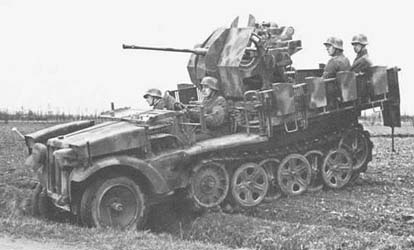 |
Sd.Kfz.10/4 leichte Selbstfahrlafette mit 2
cm Flak 30.
|
src: Site "WWII
Vehicles "
|
20
mm Flakvierling 38 L/112.5 Penetration of a shielding plate (mm) under a plunging angle of 30° |
|||||||
Ammo |
Weight |
Velocity |
100
m |
500 m |
1000
m |
1500 m |
2000
m |
| PzGr | 0.148 kg |
780 m/s |
20 |
14 |
9 |
- |
- |
| PzGr 40 | 0.1 kg |
1050 m/s |
49 |
20 |
- |
- |
- |
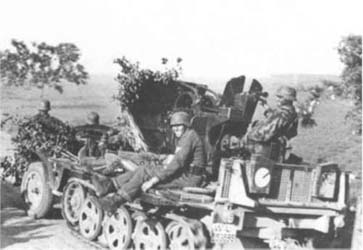 |
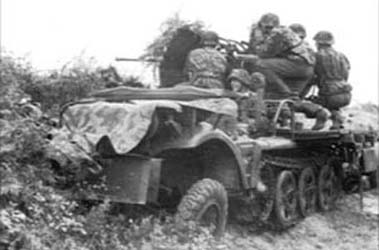 |
Sd.Kfz.10/4 leichte Selbstfahrlafette
mit 2 cm Flak 30.
|
|
src: Site "WWII
Vehicles " |
src: Site Panzer
Page von Reitsch |
Data |
Drawings |
| Sd.Kfz.10/4 Demag D II 3 (2cm Flak 30) |
| Sd.Kfz.10/4 Ausf.A (2cm Flak 30) |
| Sd.Kfz.10/4 Ausf.B (2cm Flak 30) |
| Sd.Kfz.10/5 (2cm Flak 38) |
| Sd.Kfz.10 (5cm Flak 41) |
| Sd.Kfz.10/4 Fahrschülepanzer |
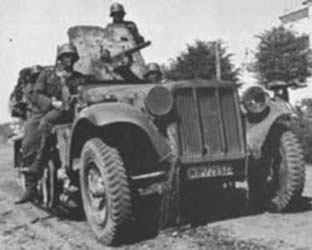 |
37 mm Pak 35/36 auf ZgKw 1t
|
src: Site "Achtung
Panzer"
|
Cette conversion fut réalisée pour rendre le canon anitchar de 37 mm Pak 35/36 L/45 plus mobile. Elle fut utilisée par les unités de Panzerjaergers. Le canon était monté tel quel à l'arrière du véhicule d'origine ou sur affût spécial. Quelques spécimens avaient des plaques de blindage supplémentaires sur les côtés du canon et devant le moteur.
This conversion was carried out to return the antitank gun Pak 35/36 L/45 of 37 mm more mobile. It was used by the units of Panzerjaergers. The gun was assembled just as it to the back of the vehicle of origin or on special mounting. Some specimens had additional armour-plates on the sides of the gun and in front of the engine.
37
mm Pak 35/36 L/45 Penetration of a shielding plate (mm) under a plunging angle of 30° |
|||||||
Ammo |
Weight |
Velocity |
100
m |
500 m |
1000
m |
1500 m |
2000
m |
| PzGr | 0.685 kg |
745 m/s |
34 |
29 |
22 |
19 |
- |
| Data Sd.Kfz.10 mit 37 mm Pak | |
| Dimensions | |
| Weight: 5500 kg - Crew: 7-8 - Length: 4.75 m - Width: 1.93 m - Height: 2 m | |
| Propulsion | |
| Engine: Maybach HL 42TURKM, 6 cyl., 100 hp - Fuel: Gasoline (110-115L) | |
| Performances | |
| Speed: 65 km/h
(on road) - 45 km/h (off road) - Range:
220-300 km (on road), ? km (off road) Turning radius (diameter): 15 m |
|
| Armament | |
| Type: 1 x 37 mm Pak 35/36 L/45 - Ammo: ? |
|
| Armor | |
none |
|
Drawings |
En 1941, de nombreux Sd.Kfz.10 furent armés avec le canon de 50 mm Pak 38 L/60 afin de créer un canon antichar léger automoteur. Le canon sans ses roues était installé à l'arrière et des plaques de blindages furent rajoutées pour compléter la protection de la cabine et du moteur. Tous furent utilisés dans par les Waffen SS sur le front est.
In 1941, many Sd.Kfz.10 were armed with the 50 mm Pak 38 L/60 gun in order to create a motorized light anti-tank gun. The gun without its wheels was installed on the back desk and armour-plates were added to supplement the protection of the cabin and the engine. All were used in by Waffen SS on the eastern front.
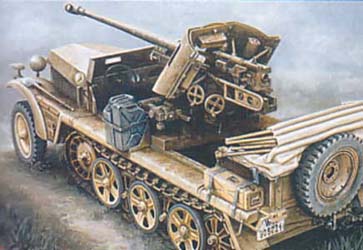 |
 |
Selbstfarlafette mit 50 mm Pak 38
auf leichte Zugkraftwagen 1t.
|
|
src: Site Lexikon
der Wehrmacht |
|
50
mm PakK 38 L/60 Penetration of a shielding plate (mm) under a plunging angle of 30° |
|||||||
Ammo |
Weight |
Velocity |
100
m |
500 m |
1000
m |
1500 m |
2000
m |
| PzGr 39 | 2.060 kg |
835 m/s |
69 |
59 |
48 |
38 |
29 |
| PzGr 40 | 0.925 kg |
1180 m/s |
130 |
72 |
38 |
- |
- |
| Data Sd.Kfz.10 mit 50 mm Pak | |
| Dimensions | |
| Weight: ? kg - Crew: 4 - Length: 4.75 m - Width: 1.93 m - Height: 2 m | |
| Propulsion | |
| Engine: Maybach HL 42TURKM, 6 cyl., 100 hp - Fuel: Gasoline (110-115L) | |
| Performances | |
| Speed: 65 km/h
(on road) - 45 km/h (off road) - Range: 220-300
km (on road), ? km (off road) Turning radius (diameter): 15 m |
|
| Armament | |
| Type: 1 x 50 mm Pak 38 L/60 - Ammo: ? |
|
| Armor | |
none |
|
Drawings |
Sd.Kfz.11
leichte Zugkraftwagen 3t / Sd.Kfz.11/1 Nebelkraftwagen /
Sd.Kfz.11/2 mittlere Entgifungkraftwagen / Sd.Kfz.11/3 mittlere Sprühkraftwagen
/
Sd.Kfz.11/4 Nebelkraftwagen / Sd.Kfz.11/5 mittlere Gasspürkraftwagen
/
20 mm Flak 38 auf Sd.Kfz.11
Le Sd.Kfz. 11 était le tracteur standard des unités d'artillerie de campagne allemandes (pièces de 75 et de 105 mm) et des Panzerjäger Abteilungen. La superstructure était composée de grands coffres à munitions situés juste derrière le poste de conduite ainsi que de sièges pour passagers. Le compartiment arrière pouvait accueillir six passagers. Il transportait 110 obus de 7.5 cm (55 par côté). Les Sd.Kfz. 11 furent construits par plusieurs firmes: Hansa-Lloyd (Borgward) HL kl 5 (1937-38) , Hansa-Lloyd (Borgward) HL kl 6 (1939-44), Adler, Auto-Union/Wanderer, Hanomag H kl 6 (1937-44), Skoda. Le Sd.Kfz.11 fut produit de 1937 à 1944 et environ 41000 exemplaires. La firme Hanomag - Hannoversche Maschinenbau AG - était le principal producteur des half-tracks de 3 tonnes et le châssis HL kl 6 fut utilisé comme base de la série des transports de troupes blindés Sd.Kfz. 251.
Sd.Kfz. 11 was the standard
tractor of the German field artillery units (75 and 105 mm guns) and of
Panzerjäger Abteilungen. The superstructure was made up of large
trunks with ammunition located just behind the driver's cab as well as
seats for passengers. The back compartment could accomodate six passengers.
It transported 110 rounds of 7.5 cm (55 per side). Sd.Kfz. 11 were built
by several firms: Hansa-Lloyd (Borgward) HL kl 5 (1937-38), Hansa-Lloyd
(Borgward) HL kl 6 (1939-44), Adler, Car-Union/Wanderer, Hanomag H kl
6 (1937-44), Skoda. Sd.Kfz.11 was produced of 1937 to 1944 and approximately
41000 specimens. The firm Hanomag - Hannoversche Maschinenbau AG - was
the principal producer of the half-track vehicles of 3 tons and chassis
HL kl 6 was used as bases for the series of armoured transport of troops
Sd.Kfz. 251.
 |
 |
Sd.Kfz.11 leichte Zugkraftwagen
3t
|
|
src: Site "WWII
Vehicles " |
src: Site Lexikon
der Wehrmacht |
 |
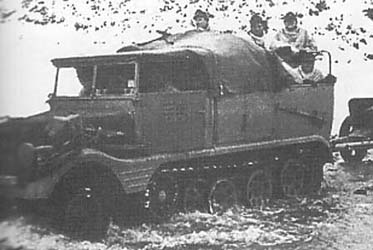 |
Sd.Kfz.11 leichte Zugkraftwagen
3t
|
|
src: Italeri |
|
| Data Sd.Kfz.11 | |
| Dimensions | |
Weight: 7200 kg - Crew: 8-9 - Length: 5.48-5.55 m - Width: 1.82-2.00 m - Height: 1.62-2.15 m |
|
| Propulsion | |
| Engine: Maybach HL 42TURKM, 6 cyl., 100 hp or Maybach NL 38, 9 cyl. 100 hp - Fuel: Gasoline (110L) | |
| Performances | |
| Speed: 53 km/h
(on road) - ? km/h (off road) - Range: 122
km (on road), 100 km (off road) Turning radius (diameter): 15 m |
|
| Armament | |
| Type: none - Ammo: none |
|
| Armor | |
none |
|
Drawings |
Sd.Kfz.11/1 Nebelkraftwagen: Generator
of smoke or transport of ammunition
Sd.Kfz.11/2 mittlere Entgiftungskraftwagen: decontamination vehicle
Sd.Kfz.11/3 mittlere Sprühkraftwagen: Vehicles of decontamination
with equipment of projection
Sd.Kfz.11/4 Nebelkraftwagen: Generator of smoke
Sd.Kfz.11/5 mittlere Gasspürkraftwagen: gas detector vehicle
Sd.Kfz.11 mit 20mm Flak 38: Mobile mounting for anti-aircraft Flak 38
gun of 20 mm
 |
Sd.Kfz.11/1 Nebelkraftwagen
|
src: Site Lexikon
der Wehrmacht
|
 |
Sd.Kfz.11/2 mittlere Entgiftungskraftwagen |
src: Site Lexikon
der Wehrmacht
|
 |
 |
Sd.Kfz.11/3 mittlere Sprühkraftwagen |
Sd.Kfz.11/4 Nebelkraftwagen |
src: Site Lexikon
der Wehrmacht |
src: Site Lexikon
der Wehrmacht |
 |
Sd.Kfz.11/5 mittlere Gasspürkraftwagen.
|
src: Site Lexikon
der Wehrmacht
|
| Data Sd.Kfz.11/2 | |
| Dimensions | |
Weight: 7200 kg - Crew: 8-9 - Length: 5.48-5.55 m - Width: 1.82-2.00 m - Height: 1.62-2.15 m |
|
| Propulsion | |
| Engine: Maybach HL 42TURKM, 6 cyl., 100 hp or Maybach NL 38, 9 cyl. 100 hp - Fuel: Gasoline (110L) | |
| Performances | |
| Speed: 53 km/h
(on road) - ? km/h (off road) - Range:
122 km (on road), 100 km (off road) Turning radius (diameter): 15 m |
|
| Armament | |
| Type: none - Ammo: none |
|
| Armor | |
none |
|
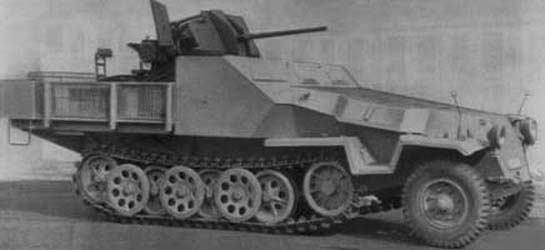 |
20 mm Flak 38 auf Sd.Kfz.11.
|
src: Site "Achtung
Panzer"
|
20
mm Flakvierling 38 L/112.5 Penetration of a shielding plate (mm) under a plunging angle of 30° |
|||||||
Ammo |
Weight |
Velocity |
100
m |
500 m |
1000
m |
1500 m |
2000
m |
| PzGr | 0.148 kg |
780 m/s |
20 |
14 |
9 |
- |
- |
| PzGr 40 | 0.1 kg |
1050 m/s |
49 |
20 |
- |
- |
- |
| Data Sd.Kfz.11 mit 20 mm Flak | |
| Dimensions | |
Weight: 8100 kg - Crew: 6 - Length: 5.80 m - Width: 2.20 m - Height: 1.80 m |
|
| Propulsion | |
| Engine: Maybach HL 42TURKM, 6 cyl., 100 hp - Fuel: Gasoline (110L) | |
| Performances | |
| Speed: 53 km/h
(on road) - ? km/h (off road) - Range:
122 km (on road), 100 km (off road) Turning radius (diameter): 15 m |
|
| Armament | |
| Type: 1 x 20 mm Flak 38 L/112.5 - Ammo: 600 |
|
| Armor | |
8-15 mm |
|
7.5 cm Pak 42 L/70 auf 3t Zugkraftwagen (Sd.Kfz.11)
En septembre 1943, Hitler ordonna l'installation du nouveau canon antichar de 75 mm Pak 42 L/70 sur un half-track. Le 28 janvier 1944, un prototype fut terminé mais donna pas entière satisfaction et le projet fut abandonné.
In September 1943, Hitler ordered the installation of the new anti-tank gun of 75 mm Pak 42 L/70 on a half-tracked vehicle. January 28, 1944, a prototype was finished but did not give whole satisfaction and the project was abandoned.
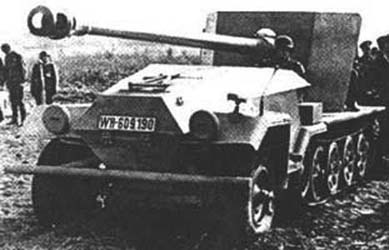 |
Sd.Kfz.251
mit 75 mm Pak 42 L/70
|
src: Site Lexikon
der Wehrmacht
|
Drawings |
Sources:
- Connaissance de l'Histoire (Hachette) - N°5 - " Véhicules blindés allemands 39-45"
- Site "Achtung Panzer" - http://www.achtungpanzer.com
- Site "WWII Vehicles" - http://www.wwiivehicles.com
- Site "Second World War Armour" - http://www.onwar.com/tanks/index.htm



